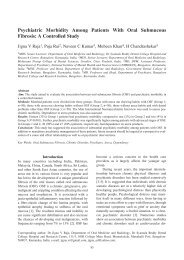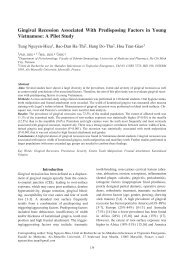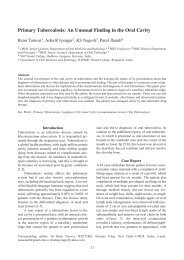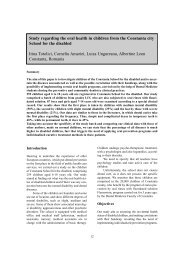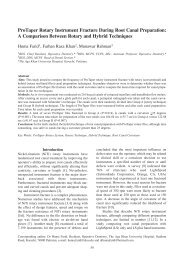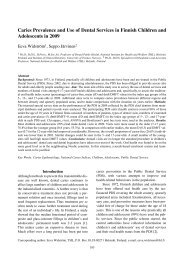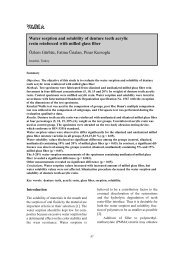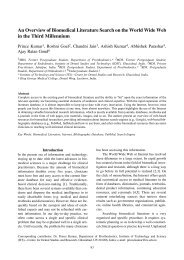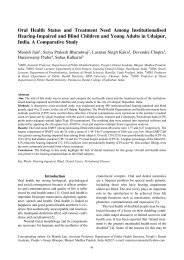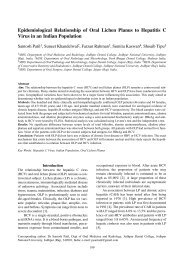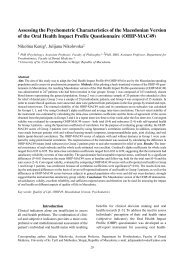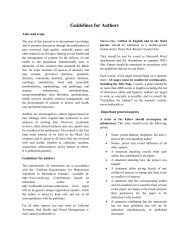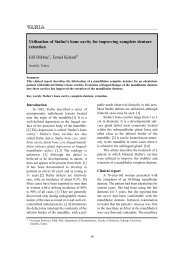Dental restoration with composite materials in the posterior zone
Dental restoration with composite materials in the posterior zone
Dental restoration with composite materials in the posterior zone
Create successful ePaper yourself
Turn your PDF publications into a flip-book with our unique Google optimized e-Paper software.
OHDMBSC - Vol. VII - Supplement - June, 2008<br />
portion of best material (superficial surface) is<br />
removed through <strong>the</strong> shap<strong>in</strong>g procedure, thus<br />
reduc<strong>in</strong>g <strong>the</strong> quality of <strong>the</strong> <strong>restoration</strong> procedure.<br />
Start<strong>in</strong>g from <strong>the</strong>se issues, we considered <strong>the</strong><br />
possibility of creat<strong>in</strong>g an silicone putty matrix that<br />
would be used for better model<strong>in</strong>g <strong>the</strong> surface of<br />
<strong>the</strong> <strong>restoration</strong>, reduc<strong>in</strong>g <strong>the</strong> need for extra shap<strong>in</strong>g<br />
and thus elim<strong>in</strong>at<strong>in</strong>g <strong>the</strong> above mentioned disadvantages.<br />
Material and method<br />
“In vivo” study<br />
Follow<strong>in</strong>g a thorough cl<strong>in</strong>ical and radiological<br />
exam, <strong>the</strong> portion that needs <strong>restoration</strong> is isolated<br />
<strong>in</strong> order to prevent saliva <strong>in</strong>filtration and consequent<br />
bond<strong>in</strong>g problems. In case <strong>the</strong> occlusal surface<br />
presents deep pits and grooves, bond<strong>in</strong>g agent<br />
(res<strong>in</strong>) is applied (<strong>with</strong>out acid upon <strong>the</strong> enamel) –<br />
<strong>in</strong> order to create a more favorable occlusal anatomy<br />
(fig.1).<br />
Fig 1. Cavity diagnosis<br />
Retentions and impression adhesives are<br />
applied on a spatula (fig 2).<br />
Then, an impression polyv<strong>in</strong>ylsiloxane material<br />
is <strong>in</strong>jected (Extrude, Kerr, Romulus, MI, SUA).<br />
Express impression material produced by 3M<br />
was used to perform this study.<br />
The preparation technique described by<br />
Simonsens or Swift for preventive res<strong>in</strong> <strong>restoration</strong>s<br />
is performed next [3]. Cavity lesions are<br />
removed sacrific<strong>in</strong>g a m<strong>in</strong>imum dental structure,<br />
us<strong>in</strong>g high-speed small rounded bur such as a 329<br />
or 2 or diamond bur. No extension of <strong>the</strong> treatment<br />
<strong>in</strong> <strong>the</strong> pits or fissure <strong>in</strong> <strong>the</strong> non-cavity areas will be<br />
done and <strong>with</strong>out sharp <strong>in</strong>ternal angles [4,5].<br />
With<strong>in</strong> <strong>the</strong> deep cavities, where dent<strong>in</strong> is less<br />
than 0,5 mm thick, a th<strong>in</strong> layer of CaOH is recommended<br />
[5,6]<br />
On <strong>the</strong> rema<strong>in</strong><strong>in</strong>g dent<strong>in</strong>, a glass-ionomer<br />
cured cement layer (Vitrebond, Irv<strong>in</strong>e) is placed, <strong>in</strong><br />
order to release fluoride and to reduce percolation<br />
[1,2].<br />
Phosphoric acid 37% gel (Scothbond Etchant,<br />
3M-ESPE) is placed on enamel for 30 seconds,<br />
r<strong>in</strong>se for 20 seconds, and dry <strong>with</strong> uncontam<strong>in</strong>ated<br />
air <strong>with</strong> oil drops. A bond<strong>in</strong>g agent can be now<br />
placed on <strong>the</strong> rema<strong>in</strong>ed dent<strong>in</strong>.<br />
O<strong>the</strong>rwise, a bond<strong>in</strong>g agent (ProBond, L.D.<br />
Caulk) is applied and will be cured for 20 seconds.<br />
ProBond bond<strong>in</strong>g agent streng<strong>the</strong>ns rema<strong>in</strong><strong>in</strong>g<br />
tooth structure while elim<strong>in</strong>at<strong>in</strong>g postoperative sensitivity.<br />
The choice of <strong>composite</strong> <strong>in</strong> <strong>the</strong> <strong>posterior</strong> area is<br />
made upon <strong>the</strong> cl<strong>in</strong>ical performances.<br />
For this study an cured nano-filled <strong>composite</strong><br />
(Filtek Supreme, 3M-ESPE) was used because it<br />
has high wear resistance, it is radioopaque and filters<br />
<strong>the</strong> fluoride [7, 8]<br />
The <strong>composite</strong> is applied <strong>in</strong> layers - no more<br />
than 2 mm - <strong>in</strong> order to reduce <strong>the</strong> bond<strong>in</strong>g contraction<br />
and <strong>the</strong> consequent marg<strong>in</strong>al gaps.<br />
Each layer is cured for 40 seconds. For polymerization,<br />
a conventional quartz tungsten halogen<br />
light-cur<strong>in</strong>g unit (XL 2500, 3M ESPE, USA) calibrated<br />
at 500 m W/ cm² was used from a distance<br />
of 0.5 mm from its outer surface.<br />
The matrix is lubricated (fig.3) <strong>with</strong> bond<strong>in</strong>g<br />
adhesive <strong>in</strong> order to prevent stick<strong>in</strong>g between <strong>the</strong><br />
<strong>composite</strong> and <strong>the</strong> impression material.<br />
Fig 2. Spatula carry<strong>in</strong>g retentions.<br />
The spatula is placed gently upon <strong>the</strong> occlusal<br />
surface, <strong>in</strong> <strong>the</strong> area that needs <strong>restoration</strong>, until <strong>the</strong><br />
material bonds. All rema<strong>in</strong><strong>in</strong>g from <strong>the</strong> impression<br />
are removed. The matrix is placed aga<strong>in</strong> to make<br />
sure it resents <strong>the</strong> necessary degree of stability.<br />
Fig 3. The impression lubricated <strong>with</strong> a th<strong>in</strong><br />
bond<strong>in</strong>g layer <strong>in</strong> order to prevent stick<strong>in</strong>g between<br />
<strong>the</strong> <strong>composite</strong> and <strong>the</strong> impression material<br />
8




